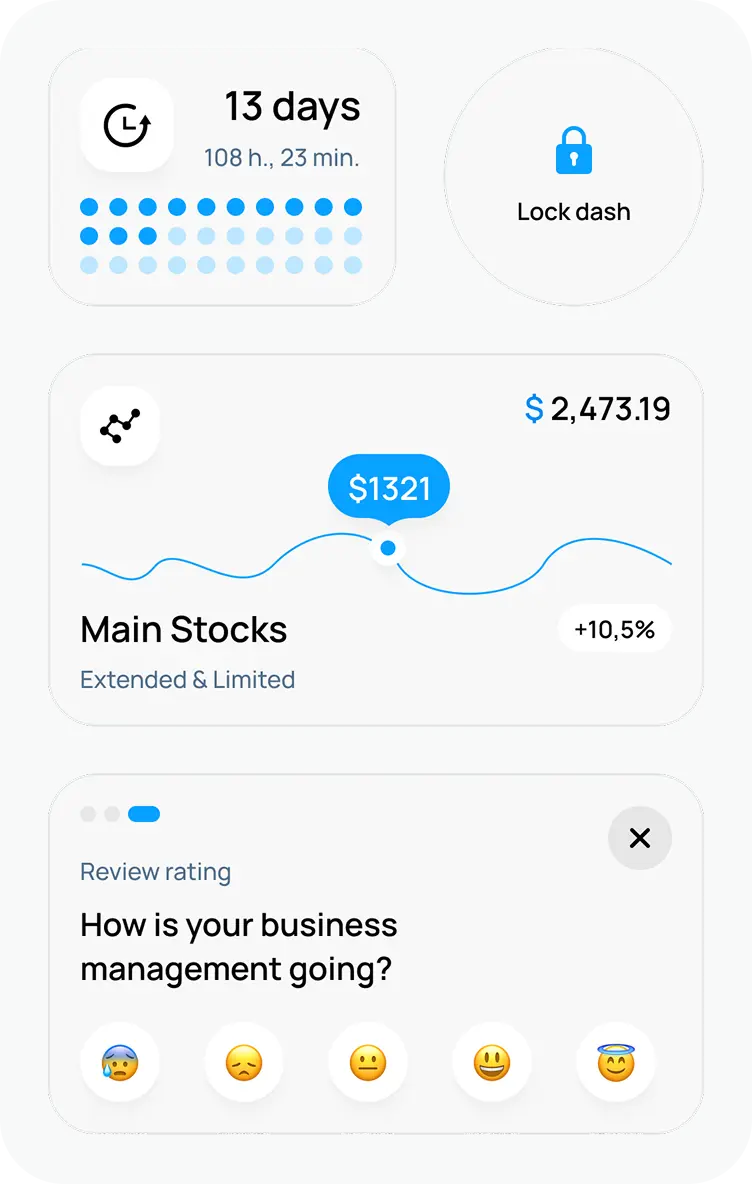UI Trends in 2025 for SaaS Companies
December 2, 2024•11 min read

I hope you enjoy reading this post. If you want us to do your frontend development or design, click here.
Author: Alex Vasylenko | Founder of The Frontend Company


Christmas is coming, and it's time to pause, reflect, and plan updates for your business in the coming year. To build a strategy and select the correct features, you need to know what's in demand and the key UI/UX trends for SaaS platforms. After all, businesses want to rely on your product for efficiency, clarity, and an experience that matches their needs.
In this post, I have collected the most relevant UI trends in 2025. By reading it, you will discover which features are most useful and explore real-life implementation examples. Let's get started!
1. Customizable Dashboards

B2B and SaaS platforms must have interactive, customizable dashboards, as this is a key UI trend for 2025 and the foundation for good data management and decision-making. These dashboards allow users to rearrange widgets, filter data, and save personalized views so they can focus on the KPIs that are relevant to their roles.
Advanced data visualization techniques like radial charts, heat maps, and dynamic trend animations make complex data more readable and actionable. This combination of flexibility and clarity allows users to make informed, fast, and data-driven decisions.
Why it matters
This is important because platforms and applications are becoming more complex as the amount of data required for decision-making grows annually. Customizable dashboards solve this problem by giving users the tools to sort, filter, and structure data according to their needs, reducing overwhelm and increasing efficiency.
Additionally, SaaS platforms serve different groups of users, each with different requirements. For example, a strategist might need a high level overview of performance metrics, while a financial analyst needs detailed budget tracking.
Giving users control over their interfaces makes them feel more ownership and overall satisfaction with the platform.
As we move into 2025, the reliance on data to drive business decisions will only grow so customizable dashboards will be more important than ever.
Example:
Microsoft Power BI reveals powerful insights and turns them into impact. By including customizable dashboards in its management platform, Microsoft allows users to track their work and progress based on individual priorities. With drag-and-drop widgets and interactive features, teams can create dashboards that fit their unique workflows.
2. AI-Powered Recommendations

AI features are a must-have for every platform, turning data into actionable insights rather than just raw information. For example, in sales and marketing platforms, AI uses predictive analytics to help users identify potential opportunities or risks and suggest actions based on data trends.
Additionally, personalized recommendations boost the user experience by suggesting the best workflow steps, content, or tools tailored to each user's behavior and preferences. Looking forward, AI-powered insights will likely remain a dominant UI/UX trend in 2025.
Why It Matters
The success of tools like OpenAI’s ChatGPT has accelerated the adoption of AI in business platforms, and it’s a big win across industries. Every business has unique insights that can provide clients with highly personalized recommendations to grow and succeed.
Integrating AI-driven recommendations is especially powerful when tied to user behavior on the platform. By analyzing how users behave with the product and their actions, businesses can give them tailored suggestions to increase overall user satisfaction.
Giving insights not only makes the platform unique but also increases user engagement by showing you understand their needs. As your business grows with more data, AI-powered recommendations will be a crucial trend for results and long-term loyalty.
Example:
Salesforce’s AI platform Einstein analyzes user behavior, customer interactions and sales data to offer predictive insights and personalized suggestions.
For instance:
Sales Teams get prioritized leads based on AI predictions of which prospects will convert.
Customer Support agents get suggested actions to resolve cases faster, improving response times and customer satisfaction.
Marketing Teams get recommendations for optimizing campaign strategies, such as which segments to target or what content will resonate most.
By integrating these features, Salesforce increases user productivity and helps businesses make better data-driven decisions at every level.
Want to Add AI-Powered Recommendations or Smart Dashboards?
3. Collaborative Features

With remote work and hybrid models here to stay, many B2B platforms will have built-in collaboration tools in 2025. Thanks to them, users can comment, tag colleagues, or start a conversation within the platform, no need to jump between different apps.
Collaborative editing, file sharing, and real-time chat features help to streamline workflows within the same UI, allowing faster, more efficient teamwork.
Why It Matters
Collaboration is crucial for real-time interaction and productivity, especially in a remote or hybrid work environment. Built-in collaborative features help to improve team efficiency and user retention.
When users and clients can collaborate directly within the platform, they become more engaged and invested in the product. This seamless interaction makes them depend on the platform as it becomes an integral part of their daily workflows.
For SaaS platforms, this is a competitive advantage. By reducing the need for external tools, collaborative features strengthen user loyalty and make it harder for teams to switch away from the product.
Example:
Slack has been a pioneer in collaborative features, but its evolution showcases why these tools are indispensable. Slack combines messaging, file sharing, and real-time collaboration into one platform, making it a go-to tool for remote teams.
For instance:
Customer Support Teams can pull data from integrated tools like Zendesk, comment on tickets, and resolve issues without leaving Slack.
Marketing Teams can brainstorm ideas in real time using Slack’s Huddle feature for spontaneous audio or video calls with screen sharing.
Product Teams can share files, track project updates, and coordinate tasks directly within dedicated Slack channels.
These features help to streamline workflows and keep teams connected and productive when working remotely.
4. Hyper-Personalized Onboarding

Most B2B and SaaS platforms are introducing intelligent onboarding and contextual help to simplify each learning process for their users. Walkthroughs, tooltips, and in-app tutorials adapted to the user's journey, offering guidance on advanced features when needed.
This trend allows users to get up to speed faster and explore advanced functionalities gradually, improving retention and reducing support requests.
Why It Matters
Hyper-personalized onboarding works hand-in-hand with AI-powered recommendations, boosting the user experience with guidance and intelligent suggestions. By tracking user behavior and preferences, platforms can create personalized onboarding journeys that feel intuitive and highly relevant.
For example, during a user’s first login, the platform can ask targeted questions to understand their needs and goals. Based on user’s answers, the interface can adapt to their specific requirements and show only the most relevant features and workflows. If combined with AI-driven recommendations, this onboarding process can suggest optimal settings, tips, or next steps, making the platform even more engaging and user-friendly.
This trend is a godsend because users don’t feel lost in the sea of features or dashboards when they first start using the platform.
In the future, hyper-personalized onboarding will be a standard feature for SaaS platforms in the next few years, just like AI-powered insights.
Example:
When users first log into HubSpot, it asks them a series of questions to identify goals, such as managing leads, running marketing campaigns, or tracking sales performance.
Based on the user’s answers, the interface adapts and shows the most relevant tools and features. For instance, a marketing specialist might see email campaign templates and engagement analytics, while a sales manager will see lead tracking and deal management workflows.
Additionally, HubSpot’s AI engine provides suggestions during onboarding, such as optimal email send times or highlighting underperforming campaigns that need attention. This dramatically helps users onboard faster and ensures they get value immediately.
5. Workflow Automation & Integrations

Automation is key for regular tasks. SaaS platforms offer drag-and-drop workflow builders so users can set up custom automation without technical expertise, like setting triggers for specific events or automating notifications. This trend shines in project management, customer support, and CRM software, where simplifying complex workflows makes you more productive.
Moreover, studies show that automation of routine tasks saves 45% of time spent on repetitive work and frees up resources for more important stuff.
Why It Matters
This UI trend is vital for 2025 because it lets businesses automate more of their workflow and simplify daily operations. One of the easiest and most effective ways to do this is by connecting to tools like Zapier, which gives you access to a network of integrations covering every tool and service a business might use.
For example, a project management tool connected to Zapier can create tasks from emails, update spreadsheets, and notify teams through chat tools like Slack.
Example:
Trello, a popular project management tool, shows workflow automation and integration through its Zapier integration. By connecting Trello to thousands of other applications via Zapier, users automate tasks that simplify workflows.
For instance:
Email Automation: When a team member sends an email, a new card can automatically be created in Trello, assigning the task to the right person and setting deadlines.
CRM Updates: Changes made in a CRM like HubSpot can trigger updates in Trello so the project board reflects the latest client info.
File Sharing: Files added to Google Drive can be attached to Trello cards, keeping all resources in one place.
This level of automation reduces manual work and keeps workflows across tools in sync, making it easier for teams to manage complex projects.

Transform your UI for peak performance!
🔹
Unlock seamless, high-performance frontend solutions tailored to your business.
🔹
Get an interface that outshines competitors and delights your users.
6. Unified Search & Command Palettes

As SaaS platforms get more feature-rich, navigating through endless menus and doing repetitive tasks is a pain for users. Unified search bars and command palettes solve this by giving you central access to everything you may immediately need on the platform.
With a few keystrokes, users can find specific data, jump to different sections, or execute actions like create a task or generate a report. No more memorizing menu structures or clicking through multiple layers of navigation. This makes workflows faster and more productive.
Why It Matters
Unified search and command palettes are crucial because they simplify navigation and make SaaS platforms more efficient. In 2025, users will want instant access to everything they forgot.
Example:
Notion shows how unified search and command palettes can change user experiences. With simple shortcuts like Ctrl+F or Command+F, you can access any feature or action on the platform.
For instance:
Quick Navigation: Users can jump to a specific page, project, or workspace without manually scrolling through menus.
Action Execution: Common tasks like add a new page, assign a task, or insert a table can be done from the command palette.
Global Search: The unified search feature lets users find documents, notes, or tags across their entire workspace in seconds, making it invaluable for teams managing large volumes of information.
Notion reduces the time users spend navigating and searching, giving them focus on completing tasks.
7. No-Code Customization Options

Many SaaS platforms have low-code or no-code elements, so users can customize interfaces and workflows without technical knowledge.
This 2025 UI trend allows B2B clients to tailor the software to their unique needs, which is especially valuable in CRM, ERP, and project management tools. By making UI customization more accessible, these platforms reduce dependency on developers in terms of basic changes.
Why It Matters
No-code customization options are game-changing because they put control directly into the hands of users, making platforms more flexible and intuitive. For users, this means:
Speed and Simplicity: Customizing interfaces and workflows is fast and easy, removing the need to involve IT teams or external developers for every little change.
Personalization: Users can create solutions that align with their individual needs, remove unnecessary features or steps, and increase efficiency and satisfaction.
Immediate Problem Solving: Teams can respond to changing requirements in real time, whether it’s adjusting a workflow or creating a new dashboard.
This lets users to take ownership of the platform and make it more approachable and adaptable.
Example:
ServiceNow shows no-code customization in action with its user-friendly tools that allow businesses to create custom workflows and interfaces without technical expertise.
For instance:
Custom Forms: HR teams can design onboarding forms specific to their company’s needs, add approvals, document uploads, and task assignments — all without writing a single line of code.
Workflow Automation: Operations teams can create automated workflows to handle repetitive tasks like service requests or scheduling maintenance using a drag-and-drop editor.
Dashboards: Department heads can build dashboards that display key metrics, such as employee productivity or project statuses, ensuring their teams have real-time insights.
By letting users customize workflows and interfaces themselves, ServiceNow reduces dependency on developers and IT teams so businesses can adapt their tools to changing needs.
8. Cross-Platform Interface

SaaS platforms have moved beyond simply being mobile-friendly, offering fully responsive and scalable UIs for any device, including desktops, tablets, and mobile.
Cross-platform support is incredibly respected in industries like sales and customer support, where employees are often on the move.
Why It Matters
Mobile traffic has long surpassed desktop traffic, making mobile-friendly platforms a necessity rather than an option. If your product doesn't have a mobile version and relies on desktop usage, you are going to lose a big chunk of your audience.
Users expect to have access to tools and services on the go, and platforms that do not deliver this experience often struggle with engagement and retention. By prioritizing mobile, you meet user expectations and stay competitive.
Example:
Salesforce is getting tons of mobile traffic by having a mobile app that mirrors its desktop platform. The app gives users leads management, sales opportunities tracking, and KPIs monitoring from their smartphones or tablets.
For instance:
Sales Representatives can update client information, log activities, and access real-time dashboards while on the road to meetings.
Managers can review team performance, approve deals, and get critical notifications wherever they are.
Customer Support Teams can resolve tickets and communicate with clients, delivering fast service.
By prioritizing mobile cross-platforming, Salesforce gives users consistent and reliable access to the platform anywhere.
9. Cross-Cultural Interface

As businesses go global, UI/UX design that considers cross-cultural differences and localization nuances is becoming more and more important. It includes language support, cultural relevance in design elements, and adaptability to various regional user behaviors and preferences.
By aligning design elements with regional preferences, SaaS platforms can build stronger connections with international audiences and make users feel heared and understood.
Why It Matters
This trend will remain relevant far beyond 2025 because understanding the cultural nuances of your target audience is key to a successful interface. Different regions like North America, Europe, and East Asia have different mentalities and perceptions of platforms and products. Ignoring these differences will result in a disconnected user experience that doesn’t resonate with diverse users.
This trend may not be relevant for every niche or product, but it is critical for businesses going global and leading in multiple markets.
Example:
Airbnb is a great example of a platform that excels in cross-cultural interface design. As a global business serving users from almost every region, Airbnb adjusts its UI/UX to meet the cultural and linguistic needs of its audience.
For instance:
Language Support: Airbnb is available in over 60 languages, so users can browse, book, and communicate in their own language.
Localized Content: The platform adapts imagery, descriptions, and even search filters based on regional preferences. For example, users in Japan might see listings emphasizing traditional tatami rooms, while European users might see options showcasing historical architecture.
Cultural Sensitivity: Airbnb has culturally appropriate payment methods, date formats, and customer support that meet local expectations, making the experience intuitive and seamless for all users.
Airbnb has created a platform that feels inclusive and familiar, building trust and loyalty among its global audience.
10. AR/VR Interface

The last 2025 UI trend in my list is AR/VR interfaces, an emerging technology that’s starting to shape the future of user interaction. While still in its infancy for many SaaS platforms, AR (Augmented Reality) and VR (Virtual Reality) are getting attention for their ability to deliver immersive, interactive experiences.
AR/VR interfaces allow users to visualize data, interact with products, and collaborate in ways that were previously unimaginable, offering new opportunities for industries like manufacturing, real estate, healthcare, and training.
Why It Matters
This trend is vital because AR/VR interfaces, like the Apple Vision Pro, offer hands-free experiences that could change user behavior completely. For businesses with consumer-facing products, like Microsoft Word or similar applications, adding AR/VR features can be a big opportunity to innovate and hype.
Devices like the Vision Pro are expensive now, but the price is expected to drop over the next 5-10 years, and more companies will start using them, as they could replace traditional tools like monitors, keyboards, and mouses.
This trend isn’t just about 2025 — it will define the next 10 years. Businesses that start experimenting with AR/VR today will lead the way in the future, offering unique experiences and differentiation from competitors. Investing in AR/VR now could help businesses capture new markets and stay ahead as this becomes mainstream.
Example:
Microsoft Mesh is a groundbreaking platform that brings AR/VR collaboration to life. It allows users to work together in virtual environments, regardless of their physical location. Through holograms and immersive meeting spaces, Microsoft Mesh allows teams to share 3D models, visualize complex data, and collaborate in real time.
For instance:
Design Teams can use Mesh to co-create and review product prototypes in a shared 3D workspace without being in the same room.
Engineering Teams can visualize and troubleshoot systems, like machinery or infrastructure in a virtual environment before making physical changes.
This blend of AR and VR technology demonstrates how immersive interfaces can revolutionize workflows, enhance collaboration, and redefine productivity for B2B applications.
Final Word
The most important aspect of any SaaS platform is its ability to remain modern, intuitive, fast, and relevant. By staying ahead of UI trends for 2025, businesses can improve their platforms and redefine how they interact with users, driving better engagement, productivity, and satisfaction.
I hope that this research and article have been helpful to you and have sparked some great ideas for enhancing your platform. If you have found features or trends that resonate with your vision, I would be happy to help you bring them to life.
💡 You can book a 1-hour consultation with me, where I will provide personalized insights on improving your UI and UX to attract more clients and elevate your platform. Let’s work together to turn your ideas into actionable solutions!

Unlock the full potential of your product

Boost customer retention & satisfaction

Become more competitive on the market

Move to the latest technologies stacks

Improve usability & visual appeal
FAQ

Alex Vasylenko is the founder of The Frontend Company, DBC and several other successful startups. A dynamic tech entrepreneur, he began his career as a frontend developer at Deloitte and Scandinavia's largest banking company. In 2023, Alex was honored as one of 'Top 10 Emerging Entrepreneurs' by USA Today.
RATE
Rate this article please
This will help us provide more useful information.
1752 ratings, average 4.92 out of 5
